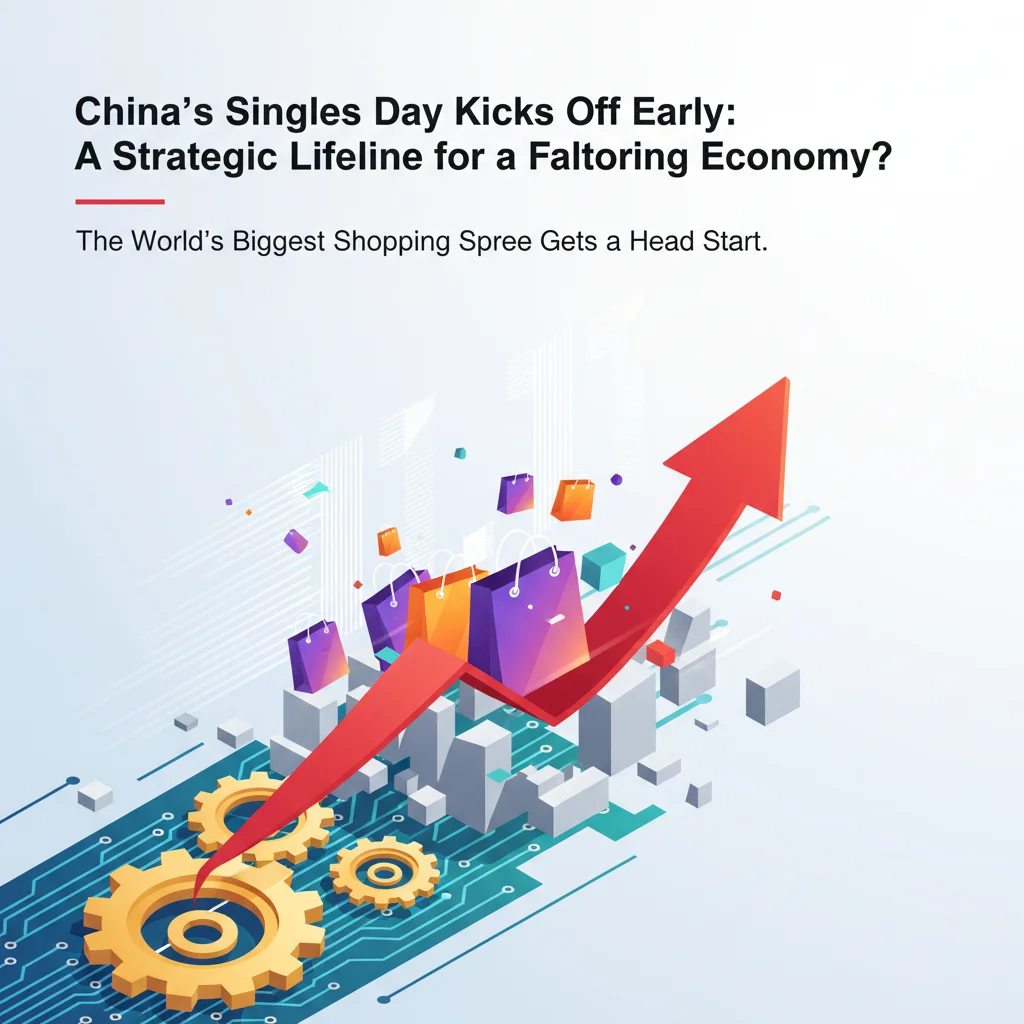
China’s Singles Day Kicks Off Early: A Strategic Lifeline for a Faltering Economy?
The World’s Biggest Shopping Spree Gets a Head Start
In the world of global commerce, few events command as much attention as China’s Singles Day. Traditionally a 24-hour online shopping frenzy on November 11th, this retail behemoth has historically shattered sales records, serving as a powerful barometer for consumer appetite in the world’s second-largest economy. This year, however, the rules have changed. In a significant departure from tradition, major e-commerce platforms like Alibaba and JD.com have kicked off the shopping festival five weeks early. The starting gun fired not on November 11th, but in late October, transforming a one-day sprint into a month-long marathon.
This strategic shift is far more than a simple marketing gimmick. It’s a calculated move reflecting deep-seated concerns within the Chinese economy and a desperate attempt to reignite consumer spending. For investors, finance professionals, and business leaders, this early start is a critical signal. It raises profound questions: Is this an act of confidence or a sign of weakness? What does it tell us about the health of Chinese consumers? And what are the broader implications for global markets, investing strategies, and the future of e-commerce?
From Niche Celebration to Global Economic Indicator
To understand the gravity of this change, one must appreciate the sheer scale of Singles Day. What began in the 1990s as a niche university celebration for single people—an “anti-Valentine’s Day”—was brilliantly co-opted by Alibaba’s then-CEO Daniel Zhang in 2009. He transformed it into a commercial powerhouse, a festival of consumption that dwarfs other global shopping events combined. The numbers are staggering. In 2021, Alibaba and JD.com collectively reported over $139 billion in Gross Merchandise Volume (GMV) during the festival period (source), a figure that eclipses the combined online sales of Black Friday and Cyber Monday in the United States several times over.
Over the years, the event has become a key data point for analysts gauging the vitality of China’s consumption engine. A strong Singles Day performance would send positive ripples through the stock market, boosting shares of e-commerce giants, logistics companies, and consumer brands. Conversely, a lackluster result could signal a worrying slowdown. The event’s evolution from a cultural moment to a crucial economic bellwether is a testament to the power of China’s consumer class and the sophisticated financial technology infrastructure that supports it.
The Investor's Crossword: Decoding the Puzzles of the Modern Economy
The Economic Headwinds Forcing a Change in Strategy
The decision to extend the sales period isn’t happening in a vacuum. It’s a direct response to a host of economic challenges currently plaguing China. For several quarters, the post-pandemic recovery that many economists predicted has failed to fully materialize. A confluence of factors has dampened consumer confidence and put a brake on spending.
Below is a snapshot of the key economic pressures that form the backdrop for this year’s extended Singles Day:
| Economic Challenge | Description & Impact |
|---|---|
| Property Sector Crisis | A protracted slump in the real estate market, a sector that accounts for a significant portion of household wealth, has made consumers feel poorer and less willing to spend on non-essential goods. |
| High Youth Unemployment | Record-high unemployment rates among young people (peaking above 21% before the government suspended data publication source) have curtailed spending power among a key demographic for e-commerce. |
| Deflationary Pressures | Falling consumer prices (deflation) can signal weak demand. Consumers may delay purchases, expecting prices to drop further, creating a vicious cycle that harms corporate profits and the broader economy. |
| Sluggish Retail Sales | While there have been pockets of growth, overall retail sales have been inconsistent, failing to meet optimistic government targets and indicating a cautious consumer mindset. |
Faced with this challenging environment, e-commerce platforms are no longer confident that a single 24-hour period can generate the record-breaking headlines of the past. By extending the event, they hope to capture consumer dollars over a longer period, lock in sales before wallets tighten further, and create a narrative of success by aggregating sales over several weeks rather than a single day.
The Fintech Backbone: Powering a Trillion-Yuan Juggernaut
The sheer operational scale of Singles Day would be impossible without one of the world’s most advanced fintech ecosystems. The seamless integration of digital payments, credit, and logistics is the unsung hero of the event. Platforms like Alipay (from Ant Group) and WeChat Pay (from Tencent) are the central nervous system, processing staggering transaction volumes with near-perfect uptime. During peak moments, these systems handle hundreds of thousands of transactions per second, a feat of financial engineering that traditional banking infrastructure would struggle to match.
This year, several financial technology trends are playing an even greater role:
- Livestreaming E-commerce: Top influencers, or “Key Opinion Leaders” (KOLs), drive billions in sales through real-time product demonstrations, creating a blend of entertainment and commerce.
- “Buy Now, Pay Later” (BNPL): Integrated micro-credit services like Huabei (“Ant Check Later”) allow consumers to make purchases and pay in installments, boosting big-ticket sales.
- AI and Big Data: Sophisticated algorithms personalize the shopping experience, offering tailored recommendations and dynamic pricing to millions of users simultaneously.
There is also growing speculation about the future role of emerging technologies. While not yet mainstream, the principles of blockchain could one day be used to enhance supply chain transparency, verify the authenticity of luxury goods, and build more robust loyalty programs. The continued innovation in fintech is crucial for sustaining the growth and efficiency of these massive sales events.
An Investor’s Playbook for the New Singles Day
For those involved in investing or trading, the extended Singles Day presents both new opportunities and new risks. The event’s performance is a proxy for the health of China’s tech giants and the broader consumer sector. Here’s what to watch:
First, the focus is shifting away from the single, eye-popping GMV figure. Since 2022, both Alibaba and JD.com have stopped releasing specific sales totals, opting instead for vague statements about “positive growth.” This lack of transparency makes analysis more difficult. Investors should instead look at:
- Category Performance: Are consumers buying high-end electronics and luxury goods, or are they sticking to household staples and discounted items? This provides insight into consumer confidence.
- Logistics Efficiency: The performance of logistics networks (like Cainiao and JD Logistics) is critical. Any major delays could signal that the system is under strain.
- Stock Market Reaction: The share price movements of Alibaba (BABA), JD.com (JD), and PDD Holdings (PDD) during and after the festival will be the market’s ultimate verdict on the event’s success.
The table below shows the historical context of Singles Day sales, illustrating the growth that platforms are now trying to protect.
| Year | Alibaba GMV (approx. USD) | Key Trend / Note |
|---|---|---|
| 2017 | $25.3 Billion | Strong double-digit growth year-over-year. |
| 2019 | $38.4 Billion | Continued robust growth, solidifying its global dominance. |
| 2021 | $84.5 Billion | Growth slows to single digits; regulatory crackdown on tech begins to bite. |
| 2022 | Not Disclosed | First year without a public GMV figure, signaling a major strategy shift. |
This year, the early start complicates year-over-year comparisons. The key question for investors is whether the extended period will generate genuinely new demand or simply pull forward sales from December and January, creating a “sales hangover” in the following quarter. The answer will have significant implications for Q4 earnings and 2024 forecasts.
From Pop Icon to Portfolio Risk: The Unseen Economics of Brand Beckham
Conclusion: A Barometer in a Storm
The decision to launch Singles Day five weeks early is a microcosm of the broader challenges and strategic pivots happening within the Chinese economy. It represents a pragmatic adaptation to a new reality of cautious consumers and intense competition. While the days of explosive, 40% year-over-year growth may be over, the event remains a formidable force in global retail and a vital data point for understanding the intricate dance of economics, consumer behavior, and financial technology.
For the world, this is more than just a story about online shopping. It’s a real-time test of China’s ability to navigate its economic headwinds and stimulate domestic demand. Whether this marathon sales event successfully props up consumption or merely highlights its underlying weakness, the results will reverberate far beyond China’s borders, influencing global supply chains, investor sentiment, and the trajectory of the world economy for months to come.


